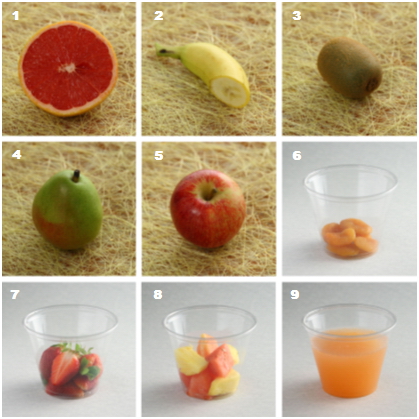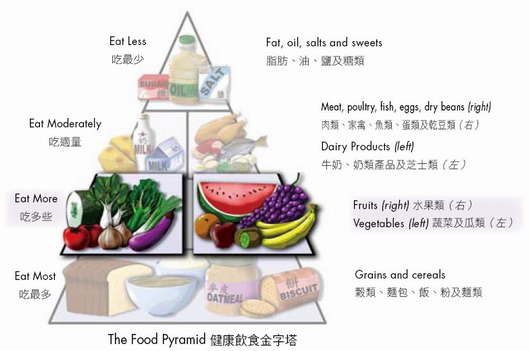
Food Safety Focus (30th Issue, January 2009) – Food Safety Platform
Nutrient and Health - Carbohydrates:
Starch and Dietary Fibre
Reported by Ms. Jacqueline FUNG, Scientific Officer,
Risk Communication Section,
Centre for Food Safety
In the last issue, we introduced the concept of food as fuel of the body. In this and the next issue, we will focus on carbohydrates. Carbohydrates are compounds consist of carbon, hydrogen and oxygen that are in a set ratio. Depending on the complexity of the chemical structures, they can be divided into simple and complex carbohydrates. We will further examine simple carbohydrates, which include monosaccharides and disaccharides, in the next issue. Here we concentrate on complex carbohydrates (i.e. polysaccharides), which we generally refer to as starch and dietary fibre in our daily life.
Starch
Starch is built of glucose units and it is the storage form of glucose in plants. Starch can be in the form of long chains of glucose molecules (amylose) or branched chains of glucose molecules (amylopectin). Through digestion, these glucose molecules are released for use. Once absorbed, glucose can be used as fuel immediately, or store as glycogen (highly branched chains of glucose molecules) in the muscle and liver for future use.
Carbohydrate is the body's preferred energy source. According to the World Health Organization's recommendation, 55-75% of energy contribution should come from carbohydrates. Grains and cereals, plus starchy vegetables, such as potatoes and yams, are rich in starch, which provide much of the food energy for us. With reference to the food pyramid, it is the bottom level which represents the "Eat Most" level. In terms of actual amount, an adult should eat 3-6 bowls of cooked rice or noodles (one bowl of cooked rice or noodles approximately equals to two slices of bread) a day.
Dietary Fibre
Dietary fibre was first described as "portion of food which is derived from cellular walls of plants which is digested very poorly by human beings". These cell walls of plant material are mainly cellulose, hemicellulose and pectin, which are non-starch polysaccharides (NSP). A non-carbohydrate component found in the cell wall, lignin, is also included in the classification of dietary fibre. In other words, not all dietary fibres are carbohydrates. In fact, dietary fibre is a diverse group of compounds. Until now, there is no consensus on the definition of dietary fibre; however, the general agreement is that NSP are the principal part of dietary fibre.
Conventionally, dietary fibres are being considered as having no energy value. Thus, the term "available carbohydrate" means total carbohydrate excluding dietary fibre as dietary fibres are not available for energy.
A simple division of dietary fibres is to group them under soluble and insoluble fibres. These two terms have widespread use and are acceptable to consumers as they have been useful in nutrition education for the understanding of the physiological properties of dietary fibres. Generally, soluble fibres have effects on glucose and lipid absorption from the small intestine thereby can help to control diabetes and prevent high blood cholesterol. Insoluble fibres, on the other hand, have more pronounced effects on bowel habit as they are slowly and incompletely fermented by microorganisms in the large intestine. Regarding food sources, fruits, oats, barley and legumes have plenty of soluble fibres, whereas vegetables, wheat and cereals have more insoluble fibres.
Positive health effects of dietary fibre are well recognised, it can help to prevent numerous chronic diseases, such as cancers and heart diseases. With reference to the Chinese Adequate Intake (AI), an adult should consume 12.6g of dietary fibre for each 1 000-kcal intake a day. In other words, a 2 000-kcal diet should have about 25g of dietary fibre. Conveying the message by using the Food Pyramid, fruits and vegetables are the main sources of dietary fibre and we should "Eat More" of these foods. A balanced and healthy diet should include a minimum of 2 servings of fruits and 3 servings of cooked vegetables (equivalent to 6-8 taels) daily. Taking the opportunity to maximise dietary fibre intake, individuals can select whole grain products whenever available.
Illustration: A Serving of Fruits 
| 1, 2 | – Half piece of large-sized fruit |
|---|---|
| 3,4,5 | – One piece of medium-sized fruit |
| 6 | – 1/4 cup of dried fruits without added sugars or salt |
| 7,8 | – Half cup of berries or cut-up fruits |
| 9 | – 3/4 cup of fresh fruits juices without added sugars |
After starch and dietary fibre, we will examine another group of carbohydrates – sugars the sweets, in the Valentine's month.
llustration: The Food Pyramid 


